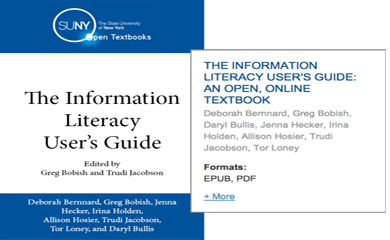
by Cyril Oberlander
 What makes a good researcher? When navigating today’s complex information ecosystem, researchers in any setting must have a variety of tools at their disposal, as well as the knowledge and focus to use them in an efficient and productive manner.
What makes a good researcher? When navigating today’s complex information ecosystem, researchers in any setting must have a variety of tools at their disposal, as well as the knowledge and focus to use them in an efficient and productive manner.
The authors of The Information Literacy User’s Guide have provided an essential roadmap for becoming a successful and self-aware researcher. This textbook introduces students to critical concepts of information literacy using relevant techniques and materials designed for maneuvering through an information-saturated and technology-rich world. Specifically, it utilizes two essential concepts: The Seven Pillars Model, developed by the Society of College, National, and University Libraries in the United Kingdom, as well as, the concept of information literacy as a “metaliteracy,” a model developed by Trudi Jacobson of SUNY University at Albany, and Thomas Mackey of SUNY Empire State College.
The Information Literacy User’s Guide examines information literacy as it relates to the liberal arts as well as the hard sciences. This textbook is designed for undergraduate level courses with a research component and information literacy courses, or for independent learning. The individual chapters can also be incorporated into one-shot sessions or flipped classrooms. Intelligently engaging, with relevant examples of real-life research pitfalls, case studies, and scenarios, this textbook offers many hands-on exercises and interactive quizzes to aid the progress of the audience from researching novices to capable information locators, creators, and sharers.
Available free online at: opensuny.org
About Open SUNY Textbooks
Open SUNY Textbooks is a ground-breaking open access textbook publishing initiative established by State University of New York libraries and supported by SUNY Innovative Instruction Technology Grants. This highly innovative initiative publishes high-quality, cost-effective course resources by engaging faculty as authors and peer-reviewers, and libraries as an integral part of the publishing infrastructure.
Launched in 2012, this pioneering initiative provides an opportunity for higher education to be more involved in publishing high-quality affordable textbooks. The first pilot will produce 15 published titles in 2013-2014, with 15 more titles to be published in a second pilot for 2014-2015. Participating libraries in the first pilot include SUNY Geneseo, College at Brockport, College of Environmental Science and Forestry, SUNY Fredonia, Upstate Medical University, and University at Buffalo, with support from other SUNY libraries and SUNY Press.
Lastly, with much appreciation to the authors and editors for making this textbook possible, we would also like to thank Chris Rudecoff (SUNY Morrisville), Allison Brown, Leah Root, and other members of the SUNY Geneseo Publishing Team, participating SUNY libraries, SUNY IITG grant funding, and SUNY Press for helping to make this publication a reality. Publishing open textbooks is as much about providing access to educational resources and lowering the cost of education, as it is about empowering teaching and learning, authors and readers.
For more information and to access these open textbooks, please see http://opensuny.org.

